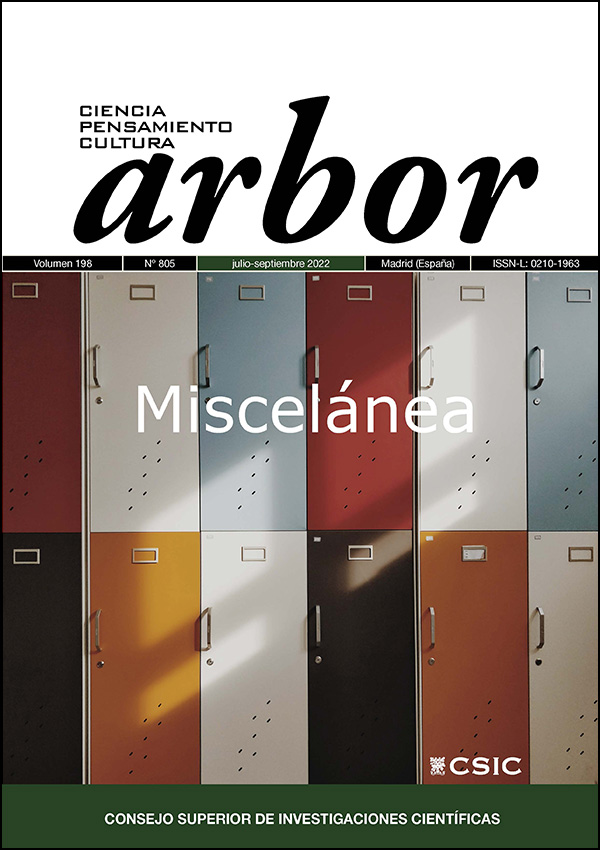Two photographs by María Egües Ortiz (1917-2008): a periscopic gaze in times of misty silence
DOI:
https://doi.org/10.3989/arbor.2023.808007Keywords:
María Egües, optical engineering, science in early Francoism, history of opticsAbstract
María Egües (1917-2008) was a researcher and technologist in the field of optical instruments and an essential player in understanding the development of optical engineering in the first decades of the Franco regime. Based on two photographs, until recently unpublished, that reflect two crucial moments in her professional life, this essay offers a reflection on how a woman like Egües saw herself at a time when the mere presence of a woman in the techno-scientific system was, more often than not, rejected or ignored. Using the metaphorical resource of submarine periscopes, which allow us to see without being seen, this technologist, like a submarine, was able to progress in institutions like the CSIC, the university, and the army, the real technological pillars of the Francoist state, in the face of hostile or suspicious gazes. Even that regime, with its, in the words of Pedro Laín “atrocious dismemberment”, which had chopped down so much of the tree of Spanish science, could not allow itself to disregard the participation of at least some women, such as Egües, who were essential in the reconstruction of a techno-scientific system, so necessary for the survival of the system itself, despite certain atavistic rhetoric. This was the case with the development of a not-inconsiderable industry of optical instruments, especially, of course, those for military use. In this field, Egües, with forced discretion and persevering effort, would reach one of the most notable milestones: the design and manufacture of the first purely Spanish periscopes of the twentieth century.
Downloads
References
Aguilera, Manuel (2009). La Quinta Columna durante el Golpe de Casado. Aportes: Revista de historia contemporánea, 24(69), 99-111. https://dialnet.unirioja.es/ejemplar/234903.
Barbero, Sergio (2022). Entre la realidad y el deseo: el desarrollo de la ingeniería óptica en España (1920-1936). Llul, 45(91), 203-229. https://recyt.fecyt.es/index.php/LLUL/article/view/98928
Busquets i Vilanova, Camil (1988). Submarinos de asalto de la Armada Española. Revista General de Marina(Armada Española), 215, 237-250.
Calvo, María Luisa y Gómez Reino, Carlos (2000). In memoriam: Armando Durán Miranda (1913-2001). Óptica Pura y Aplicada, 33, 3-16. https://opa.sedoptica.es/es/articulo/222.
Egües, Maruja (1992), Perfil humano de un delegado de curso. En: Villena, Leonardo et al. (1992), Leonardo Villena Pardo. Homenaje en su 75 Aniversario, p. 49.
Molina, Luca. La ayuda militar a España 1939-1945. Tesis doctoral, Universidad de Valladolid, 2014.
Moya de Guerra, Elvira (2002). Mujeres en Ciencia y Tecnologías Físicas en el CSIC.Arbor, 172 (679-680), 549-577. https://doi.org/10.3989/arbor.2002.i679-680.1097. https://doi.org/10.3989/arbor.2002.i679-680.1097
Muñoz Muñoz, Amelia (2015). Ciencia en defensa. Historias de los centros integrados en el Instituto tecnológico "La Marañosa". Madrid: Instituto Nacional de Técnica Aerospacial Esteban Terradas.
Pérez Fernández-Turégano, Carlos (2012), José María Otero Navascués. Ciencia y Armada en la España del siglo XX, Madrid: Consejo Superior de Investigaciones Científicas.
Quien es quien en la óptica española. María Egües de Cacho, (1963). Luz: Revista de información del Instituto de Óptica "Daza de Valdés" y del Comité Español de Iluminación, (12-Jun), 18.
Quien es quien en la óptica española. Pedro Jiménez Landi, (1965). Luz: Revista de información del Instituto de Óptica "Daza de Valdés" y del Comité Español de Iluminación, 22.
Romero de Pablos, Ana. (2016). Pioneras pero invisibles: las calculistas del Laboratorio y Taller de Investigación del Estado Mayor de la Armada. Clepsydra: Revista de Estudios de Género y Teoría Feminista 15, 49-61. https://www.ull.es/revistas/index.php/clepsydra/article/download/2591/1629/
Romero de Pablos, Ana. (2017). Mujeres científicas en la dictadura de Franco. Trayectorias investigadoras de Piedad de la Cierva y María Aránzazu Vigón. Arenal 24(2), 319-348. https://revistaseug.ugr.es/index.php/arenal/article/view/6003
Villena, Leonardo et al. (1992). Leonardo Villena Pardo. Homenaje en su 75 Aniversario. Madrid.
Villena, Leonardo (1983). José María Otero, un científico internacional. Arbor, 450, 95-108.
Weidert, Franz (1914). Entwicklung und Konstruktion der Unterseeboots-Sehrohre. Berlin: Schiffbautechnische Gesellschaft, Jahrbuch. https://doi.org/10.1007/978-3-662-25847-7
Published
How to Cite
Issue
Section
License
Copyright (c) 2023 Consejo Superior de Investigaciones Científicas (CSIC)

This work is licensed under a Creative Commons Attribution 4.0 International License.
© CSIC. Manuscripts published in both the printed and online versions of this Journal are the property of Consejo Superior de Investigaciones Científicas, and quoting this source is a requirement for any partial or full reproduction.
All contents of this electronic edition, except where otherwise noted, are distributed under a “Creative Commons Attribution 4.0 International” (CC BY 4.0) License. You may read the basic information and the legal text of the license. The indication of the CC BY 4.0 License must be expressly stated in this way when necessary.
Self-archiving in repositories, personal webpages or similar, of any version other than the published by the Editor, is not allowed.














